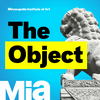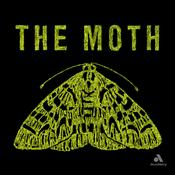101 episodes

Encore Episode: How to Live Forever (or Die Trying)
12/29/2025 | 23 mins.
NEWS! Tickets will be available starting January 7 for The Object LOVE!, our very Valentine's live show with special guest jeremy messersmith on February 7 in the Minneapolis Institute of Art's historic Pillsbury Auditorium. All about the gods in (and often out of) love, whose stories have long captured our imagination in art. Tickets are free but limited—go to the tickets page at the Mia website to reserve or for details. Now on with the show: No one lives forever. But that hasn’t stopped people from trying, and for a long time the noble way to avoid getting old and dying was to avoid getting old at all: the Greek notion of the “glorious death” that confers immortality in battle. It’s an idea that resurfaces throughout history—until it meets its match in a war of many deaths and little glory. You can see Kiss of Victory, the famous sculpture that kicks off this episode and launched the career of Sir Alfred Gilbert, in the collection of the Minneapolis Institute of Art.

The Missing Tapestries of Helena Hernmarck
12/15/2025 | 26 mins.
Brand-new episode: Swedish textile artist Helena Hernmarck became an international art star making monumental tapestries, an ancient art she gave a modern Pop Art twist starting in the 1960s. Some 260 commissioned works in all, often for corporate settings. But as the corporate world changed, and her tapestries changed hands, at least two dozen have gone missing. Now, at 84, she's scrambling to track them down, a rollicking story of international intrigue, celebrity, and what it means when culture is lost—and found. Also, big news! Tickets for the next taping of The Object LIVE! will be available starting January 7 on the Tickets page at artsmia.org. It's "The Object LOVE! Don't Go Breaking My Art!" with special guest musician jeremy messersmith, all about the gods in (and out of) love, from Orpheus and Eurydice to Eros and Psyche, with quizzes, music, and of course storytelling. Don't miss this special Valentine's edition of the podcast, recorded live at the Minneapolis Institute of Art auditorium on February 7 at 2PM. You can learn more about Hernmarck's art in the latest episode of Craft in America, airing December 19 on PBS. Hernmarck has long had a unique connection to Minnesota, and you can see more than 20 of Hernmarck's tapestries in the collection of the Minneapolis Institute of Art, a major repository of her work—including several rescued pieces. And you can see more Scandinavian craft in Mia's current show "Crowning the North," featuring Norwegian silver.

Encore Episode: A Christmas Conspiracy
12/01/2025 | 25 mins.
Tickets will be available soon for The Object LOVE!, a very Valentine’s edition of our live taping of the podcast, happening February 7 at the Minneapolis Institute of Art, with quizzes, storytelling, and very special musical guest jeremy messersmith, all about the gods in (and out of) love! It’s good to be the pope in the 1600s. But staying pope is not so easy, as the famous Barberini family finds out when one of their own takes up the tiara in 1623. As Rome fills up with their art, and dungeons fill up with their enemies, can they survive the forces of change threatening their worldview—and the forces of the occult threatening to kill the pope on Christmas Day? You can read more about the art at Mia commissioned by the Barberini family, including Pope Urban VIII, here. And of course you can see it all over Rome—in the Piazza Barberini, the Palazzo Barberini, etc. Look closely at St. Peter’s Basilica and you may see the curious Barberini family crest—a trio of bees—on fountains, frames, and even the altar. You can read about its symbolism here.

The Object LIVE! Great Gatsby's Ghost!
11/17/2025 | 55 mins.
This third sold-out live show of The Object podcast was recorded October 30, 2025, at the Minneapolis Institute of Art with special guest Chan Poling of The Suburbs and New Standards. Quizzes, storytelling, and curator conversation all centered on F. Scott Fitzgerald and his near-miraculous creation of The Great Gatsby, inspired by the cover art and a girl he met sledding in St. Paul. A big thank-you to Poling; Mia's Lori Williamson, who curated the "Gatsby at 100" exhibition; and the programs/AV team. You can see "Gatsby at 100" at Mia through March 22, 2026. And stay tuned to get your free tickets to the next edition of The Object LIVE! coming up on February 7.

Encore Episode: The Photographer Who Unvanished
11/03/2025 | 31 mins.
In the 1890s, B.A. Haldane sets up a photography studio in Alaska and begins documenting the vibrant life of his Tsimshian community—even as non-Native photographers like Edward Curtis are trekking to reservations, documenting what they believe is a "vanishing race.” Quietly contradicting a president and scientists steeped in theories of white supremacy and evolution, Haldane and other Native artists offer an alternative vision only now being rediscovered. A story of resistance and resilience and what we miss by seeing only through our own lens. You can learn more about Haldane in the work of Tsimshian scholar Mique’l Dangeli. And revisit the exhibition “In Our Hands” that featured Haldane and other Native photographers at the Minneapolis Institute of Art.
More Arts podcasts
Trending Arts podcasts
About The Object
Listen to The Object, The Moth and many other podcasts from around the world with the radio.net app

Get the free radio.net app
- Stations and podcasts to bookmark
- Stream via Wi-Fi or Bluetooth
- Supports Carplay & Android Auto
- Many other app features
Get the free radio.net app
- Stations and podcasts to bookmark
- Stream via Wi-Fi or Bluetooth
- Supports Carplay & Android Auto
- Many other app features


The Object
download the app,
start listening.





































